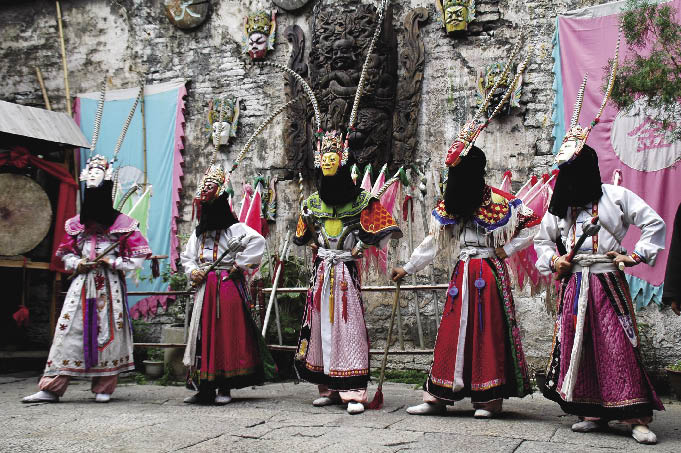|
Built in the early period of the Ming Dynasty, Yunshantun is hidden in mountains. The only ingress to the village is a twisted, stone stairway in a shadowy canyon of overhanging, precipitous mountains. The entrance gate is almost overpowered by thick ancient trees, and on the ponderous stone gate there is a tower for defensive use. Walls with a height of six meters and a length of nearly 10 kilometers flank the gate and crawl up the discouraging cliff and mountain faces on both sides, like the Great Wall itself. Walls enclose the entire village, with 14 fortresses built at strategic points.
The residences and public buildings inside the walls line up along the valley – clinging to the contour of the valley slopes – like a huge dragon, or so the villagers describe it. The front entrance – Big Tun Gate – is the dragon’s head, and the back door – Small Tun Gate, the tail. Houses at the dragon’s head date mostly to the Ming Dynasty, and those along the dragon’s body to the Qing Dynasty; the tail is characterized by a preponderance of blockhouse-style residences constructed during the modern Republic of China period. The main street – a stone slab path – cuts through the architectural mixture, and among the streetward buildings are impressive village temples and an open-air theater. Residences dominate the main street and smaller lanes that link them up. The layout of the village, its complicated lanes and sophisticated houses all amount to an ironclad surveillance and defense system. In its past the village was a booming garrison community where merchants converged, but now there are fewer than 100 shops.
Tunpu people still keep up their the traditional activity of “offering sacrifices to Mr. Wang.” This started during the Ming Dynasty and swiftly became one of the grandest local festivals. Mr. Wang (his original name was Wang Hua, a native of Anhui Province) was a brilliant war hero in the seventh century. According to historical records, in the early period of the Ming Dynasty, Emperor Zhu Yuanzhang built many temples around Anhui Province in commemoration of Mr. Wang. Every year on Mr. Wang’s birthday, officials would hold a public memorial ceremony for him. This old custom was brought into Guizhou from Anhui by ancient Tunpu people, who also built a temple for Mr. Wang and thereafter offered annual sacrifices to him.
Dixi: the Living Fossil of Chinese Opera Art
Among the many surviving Tunpu customs, scholars believe Dixi, or earth opera, enjoys the highest cultural value. It is referred to by researchers as a living fossil of Chinese opera art. Dixi is performed only at the beginning of the spring, or in the seventh moon – harvest time on the agricultural calendar.
 |
|
Gender-bending to survive: Dixi is a "living fossil" of military-themed, male-only opera that today’s women don the mask to preserve.
China Foto Press |
Dixi performers are normally local Tunpu. A performance requires the actors to cover their faces with black gauze before placing the wooden carved masks decorated with long pheasant feathers on their forehead. They wear unadorned cloth robes and wield props of wooden weapons. The singers are accompanied on gong and drum. As the opera opens, a lead singer does a high-pitched delivery of Yiyang Ancient Tune, a vocal genre that was popular in Anhui, Jiangsu and Zhejiang provinces in the early and middle period of the Ming Dynasty. Other singers join in the chorus. Battles are traditionally the favorite topics of Dixi, such as Cannonization of Gods and Romance of the Three Kingdoms. What is interesting is that Dixi themes work with orthodox ideas and would never involve the high romance of rebellion or love. It is said that the reason is directly related to the military calling of the performers. Dixi was designed to show garrison troops’ patriotism and imperial allegiance.
|
